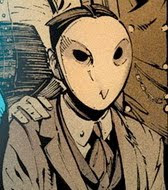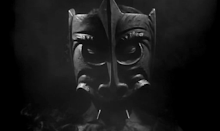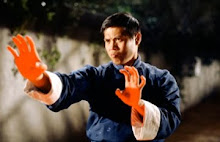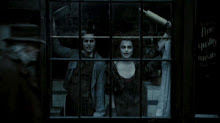There is perhaps no word in horror criticism as overused as
nightmarish, which tends to be a lazy way of saying either, “Something weird is
shown happening,” or the narrative cause and effect is slightly more opaque
than “Der’s a bomb ind da builting! GED OUD!”
Films that actually that attempt to capture the lurching,
yet lucid dislocative feel of a nightmare are rare, the ones that actually
achieve this tone are rarer still and of these arguably none have captured the
feel of being trapped in the dark corners of ones own mind than The Vampyr.
Perhaps nothing demonstrates this better than what a
particularly tough film it is to get a grasp on. I always remember it as a silent film, which it is of course
not (the film has both a score and limited dialogue). It’s a film that I’ve
seen discussed as one of the last works of European expressionism, but that’s
not really correct either, aside from a few gothic flourishes The Vampyr is a
film that very much takes place in the real world. Indeed this is the very
thing that gives its most intense imagery such extraordinary power. It is much
more closely linked to surrealism than expressionism, as what it portrays is a
very ordinary world invaded by the uncanny, as opposed to a world seen through
the twisted perspective of the uncanny. But even this description falls short
in describing the austere feel of the film. The Vampyr, like all of Dreyer’s
films is simply unquantifiable. And trying to
describe what school it belongs to or the curious effect that watching it has,
is in a lot of ways just as fruitful as- well trying to explain to a
disinterested friend about the really weird dream you had last night.
As is describing the plot. And once again we have the odd
shifting perspectives around the film. I’ve heard the film’s story described in
fairly straight forward terms, and can’t help but wonder if I am alone in
finding the movie truly and deeply weird on a narrative level. The Vampyr
follows a young man, who comes to an ominous European village and eventually
makes his way to first a haunted castle, and then a country manor, where the
daughter of the homeowner is under the attack of a Vampire(yr). This might
sound fairly straight forward, but that doesn’t convey the oddness of how everything
fits together. The Vampyr is a film where cause and effect have a distant
chilly relationship, and are not necessarily on speaking terms with one
another. Things just sort of happen in Dreyer’s film, with the protagonist
buffeted along to observe scene after scene that just don’t really fit
together. There is no Lynch like tipping of the hand, every scene is played
more or less on the level. It’s just that they seem to follow their own
inscrutable tidal pull rather than traditional story structure.
When for example the protagonist is first warned of the
threat, it is by an old man who breaks into his inn room, stares at him for
awhile says “She Must Not Die.” Gives no further explination, leaves a brown
paper wrapped package upon which he casually inscribes “To be opened in the
event of my death.” And then leaves. If the main character finds this at all
odd he keeps it to himself.
And this is an expository scene.
This leads to one of the two most famous scenes in the film
where he wanders to an abandon castle (once again note that this is pretty much
a matter of impulse rather than logical narrative progression) and finds it
filled with dancing shadows that have become untethered from their owners. The
sequence would almost be whimsical (a word you won’t hear much in Dreyer) if it
weren’t so unsettling, and of course no explination is offered.
The rest of the vampire does offer some of the traditional
features of the vampire tale. The helpless victim preyed upon (in daylight, in
the middle of the road and with the vampire itself portrayed as a wizened old
woman, her face deformed by age [something of a motif in the film]. All signs of Dreyer once again bucking
traditional imagery), the disinterment and staking of the creature, the
tracking and killing of its familiar (the village doctor who looks for all the
world like the secret love child of Mark Twain and Nietzsche). Yet it all
feels, well not perfunctory but distant. One of the oddest features of the film
is that the hero never seems to be in any danger from the vampire. Even the
film’s most famous sequence in which he “dies” and then witnesses his own
burial from the inside of a coffin with a glass window, is ultimately revealed
to be a dream, or at most a vision sent to him as a kind of passive aggressive
revenge.
To say that Dreyer was uninterested in the vampire would be
unfair, both to Dreyer and to the vampire. But it would be fair to say that
perhaps he saw them more as a symptom than an end to themselves. They are only
one aspect of the uncanny, which The Vampyr arguably portrays better than any
other film. After all, no director was better than Dreyer at portraying people
struggling for contact with the divine and here he has its dark opposite,
equally inexplicable and unknowable. It’s a force that twists the world of shape
and warps the story. Powerful enough that it literally rents shadows from the
bodies that cast them. Perhaps that’s what makes The Vampyr such a hard film to
get a hold of and describe, it’s like watching a film with a gravity well
embedded in its center.






































































































3 comments:
We all have to accept the fact of the changes in our environment.
Domain reseller
cheapest domain reseller
I just saw the film earlier today as I'm nearly finishing up my review which I'll post in a few days.
I really liked the atmosphere Dreyer created though it took a while to really get invested in the story.
Oh hey, it's the thing I requested! I love this movie when I watch it at the right time, but if I try to watch it at the wrong time, it just does absolutely nothing for me.
Hope this gave you a respite from watching complete piles of shit!
Post a Comment